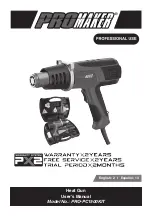
page 2
1.
Choose a hoist with the capacity for the job.
Know the capaci-
ties of your hoists and the weight of your loads, then match them.
2.
The application, size and type of load,
attachments and period
of use must be taken into consideration when selecting the right
hoist for the job.
3.
Do not operate a damaged or malfunctioning hoist.
Do not
operate a hoist with a twisted, kinked or damaged chain.
4.
Make sure the hoist suspension hook is securely attached
to a support that has sufficient strength to hold several
times the rated load of the hoist.
5.
All hoists should be visually inspected before use in addi-
tion to regular, periodic maintenance inspections.
Inspect
hoists regularly and insure that operational warning labels and tubes
are legible. Replace damaged or worn parts and keep appropriate
records of maintenance.
6.
Make sure that load slings (or other approved single attach-
ments) are properly sized and seated in the hook saddle.
7.
Make sure that the hook latch, if used, is closed and not
supporting any part of the load.
8.
Replace damaged or malfunctioning hook latches
.
9.
Check hoist for gouged, twisted or distorted chain links.
10.
Chains should be checked for deposits of foreign material
which may be carried into the hoist mechanism.
11.
Deficiencies should be noted and brought to the attention
of a supervisor. Be sure defective hoists are tagged and
taken out of service until repairs are made. Under no cir-
cumstances should you operate a malfunctioning hoist.
12.
Hoists were designed to ease our burden, carelessness not
only endangers the operator, but in many cases, a valuable
load.
13.
Become familiar with hoist operating controls, procedures
and warnings.
14.
Maintain firm footing or be otherwise secured when operat-
ing hoist.
15.
Do not operate with hoist head resting against any object. Lift
the load gently. Do not jerk it.
16.
Do not lift people or loads over people.
17.
Make sure everyone is clear of the load when you lift.
18.
Do not remove or obscure operational warning notices.
19.
Make sure that the load is free to move and will clear all ob-
structions.
WARNING!
READ AND UNDERSTAND ALL INSTRUCTIONS
Failure to follow all instructions listed below may result
in serious personal injury to the operator or nearby person-
nel by nature of released load or broken hoist components.
SAVE THESE INSTRUCTIONS
The following are guidelines for the safe operation of overhead hoists. A few minutes spent reading these rules can make an operator aware of
dangerous practices to avoid and precautions to take for personal safety and the safety of others. Frequent examinations and periodic inspections
of the equipment as well as the use of "common sense" and observance of safety rules may save lives, time and money.
20.
Take up slack chain carefully, check load balance, lift a few
inches (centimeters) and check load holding action before
continuing.
21.
Avoid swinging of load or load hook.
22.
Use hook latches wherever possible.
23.
Hooks that are bent, worn or have openings that are en-
larged beyond normal should not be used. If latch does not
engage throat opening of hook, hoist should be taken out of
service.
24.
Check brake for evidence of slippage under load.
25.
Do not lift more than the rated load.
26.
Be sure hoist is solidly held in the uppermost part of the
support hook arc.
27.
Do not lift at an angle. Be sure hoist and load are in a straight
line.
28.
Be sure load is hooked securely. Do not tip load the hook.
Do not load hook latch. Hook latch is to prevent detachment
of load under slack chain conditions only.
29.
Do not lift a load unless chain is properly seated in chain
w h e e l .
30.
Do not use load chain as a sling or wrap chain around the
load.
31.
Do not lift a load if any binding prevents equal loading on all
supporting chains.
32.
Do not operate hoist with other than manual power.
33.
Do not allow your attention to be diverted from operating
the hoist.
34.
Do not operate hoist beyond limits of load chain travel.
35.
Do not leave a suspended load unattended unless appropri-
ate precautions have been taken.
36.
Do not allow sharp contact between two hoists or between
hoist and obstructions.
37.
Protect load chain from weld spatter or other damaging
contaminates.
38.
Do not allow the chain or hook to be used as a ground for
welding.
39.
Do not allow the chain or hook to be touched by a live weld-
ing electrode.
40.
Hoists should be kept clean and free of dust, dirt, moisture,
etc. which will in any way affect the operation or safety of
the equipment.
GENERAL SAFETY RULES
HOIST SELECTION
HOIST INSPECTION
HOIST USE
HOIST OPERATOR SERVICE



































